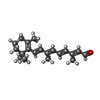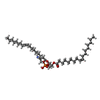+Search query
-Structure paper
| Title | Structures of channelrhodopsin paralogs in peptidiscs explain their contrasting K and Na selectivities. |
|---|---|
| Journal, issue, pages | Nat Commun, Vol. 14, Issue 1, Page 4365, Year 2023 |
| Publish date | Jul 20, 2023 |
 Authors Authors | Takefumi Morizumi / Kyumhyuk Kim / Hai Li / Elena G Govorunova / Oleg A Sineshchekov / Yumei Wang / Lei Zheng / Éva Bertalan / Ana-Nicoleta Bondar / Azam Askari / Leonid S Brown / John L Spudich / Oliver P Ernst /     |
| PubMed Abstract | Kalium channelrhodopsin 1 from Hyphochytrium catenoides (HcKCR1) is a light-gated channel used for optogenetic silencing of mammalian neurons. It selects K over Na in the absence of the canonical ...Kalium channelrhodopsin 1 from Hyphochytrium catenoides (HcKCR1) is a light-gated channel used for optogenetic silencing of mammalian neurons. It selects K over Na in the absence of the canonical tetrameric K selectivity filter found universally in voltage- and ligand-gated channels. The genome of H. catenoides also encodes a highly homologous cation channelrhodopsin (HcCCR), a Na channel with >100-fold larger Na to K permeability ratio. Here, we use cryo-electron microscopy to determine atomic structures of these two channels embedded in peptidiscs to elucidate structural foundations of their dramatically different cation selectivity. Together with structure-guided mutagenesis, we show that K versus Na selectivity is determined at two distinct sites on the putative ion conduction pathway: in a patch of critical residues in the intracellular segment (Leu69/Phe69, Ile73/Ser73 and Asp116) and within a cluster of aromatic residues in the extracellular segment (primarily, Trp102 and Tyr222). The two filters are on the opposite sides of the photoactive site involved in channel gating. |
 External links External links |  Nat Commun / Nat Commun /  PubMed:37474513 / PubMed:37474513 /  PubMed Central PubMed Central |
| Methods | EM (single particle) |
| Resolution | 2.84 - 2.88 Å |
| Structure data | EMDB-40062, PDB-8gi8: EMDB-40063, PDB-8gi9: |
| Chemicals |  ChemComp-RET:  ChemComp-NA:  ChemComp-CLR:  ChemComp-PEE:  ChemComp-HOH: |
| Source |
|
 Keywords Keywords |  TRANSPORT PROTEIN / TRANSPORT PROTEIN /  Retinal Protein / Retinal Protein /  Channelrhodopsin / Channelrhodopsin /  Cation channel / Peptidisc / Cation channel / Peptidisc /  Optogenetics Optogenetics |
 Movie
Movie Controller
Controller Structure viewers
Structure viewers About Yorodumi Papers
About Yorodumi Papers







 hyphochytrium catenoides (eukaryote)
hyphochytrium catenoides (eukaryote)